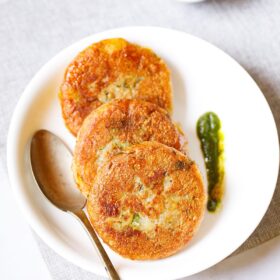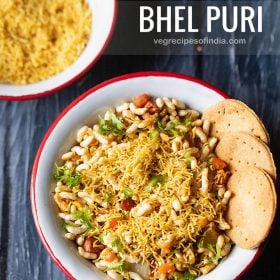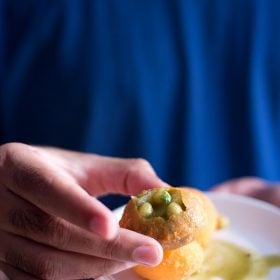Dahi Bhalla
Dahi Bhalla, also known as Dahi Bhalle, is a well-loved street snack originating from North India, especially popular in Delhi and Punjab. It has various regional versions found across India, yet the core remains consistent: lentil batter fritters fried to perfection, soaked in water, and topped with chilled yogurt and essential chaat toppings. It’s a delightful treat for the taste buds, no matter the regional twist. A fun fact – ‘Bhalla’ is also a popular Indian surname!


About Dahi Bhalla
The Punjabi Dahi Bhalla has many cousins, which are well-known in other regions across the Indian subcontinent. Here are some examples: in Hindi, it’s called dahi vada; in Marathi, dahi vade; in Bengali, doi bora; in Odiya, dahi bara; in Tamil, thayir vadai; in Kannada, mosaru vade; in Telugu, perugu vada; and in Malayalam, thairu vada.
Essentially, this chaat dish consists of fried lentil fritters or pakode, which are soaked in water, squeezed, and then finished with a generous helping of thick curd, chutneys, spice powders and other toppings that are a must in any chaat preparation. It tastes best when chilled yogurt is added.
The method of making Dahi Bhalla is like that of preparing Dahi Vada and is quite time consuming and effort worthy. But all in all, the recipe is simple and if you follow it well, then you won’t have a problem in getting this dish together easily.
However, there are some differences in both these versions of this quintessential chaat dish, which make both these distinct:
- The primary lentil that is used to make the vadas for a dahi vada is urad dal or split husked black gram only. Whereas most of the bhalle have a combination of urad dal and moong dal or split husked green gram (yellow lentils).
- In Dahi Bhalla, papdis (fried flat flour crispies), boiled potato cubes and cooked chickpeas are added. These are not a part of a typical dahi vada.
The taste and texture of Dahi Bhalla is quite versatile as there are varied elements that go into it. There’s a perfect balance of sweet, sour, salty, spicy and tangy in this dish, just like any other chaat preparation. In fact, this Indian dish aptly fits in the term ‘umami’ as well.
I make Dahi Bhalla as well as dahi vada usually during festive occasions like Holi or Diwali, or when we have a get-together or party at home. This specific recipe serves about 20 to 22 people, if each person is served 2 bhalle. You can halve this recipe too.
Since this is a Dahi Bhalla post, I have used both urad dal and moong dal in the recipe of bhalle. I have also used fresh homemade thick curd and I would suggest using the same as much as possible. This recipe is also a no onion, no garlic version as in the green chutney too, I haven’t used any of these ingredients.
As I mentioned earlier too, making Dahi Bhalla does take time. So, it’s best to plan it well. For instance, you can make the sweet imli ki chutney and green chutney a day prior. The chickpeas can also be cooked a day before and refrigerated.
You can also prepare the bhalle one day earlier. Soak them in water, squeeze out the water and refrigerate. The papdis too can be made at home or brought from the market. Dahi Bhalla is usually served chilled as a snack or starter or with any North Indian meal.
Step-by-Step Guide
How to make Dahi Bhalla
Making batter
1. Rinse ½ cup urad dal and 4 tablespoons moong dal in water a couple of times. Then, soak both the lentils overnight or for at least 4 to 5 hours.


2. Drain them very well.
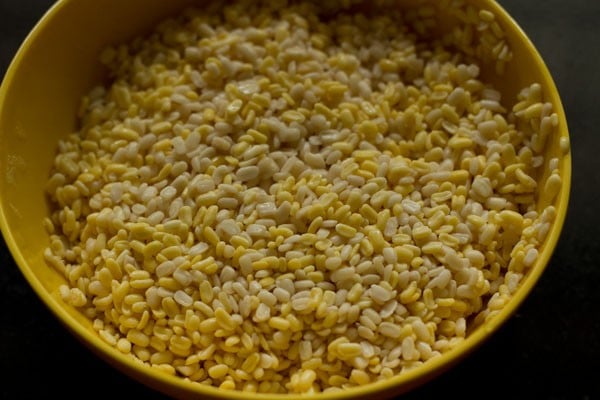

3. Add the lentils to a grinder jar along with ½ teaspoon cumin seeds and a generous pinch of asafoetida (hing). You can also add 1 teaspoon roughly chopped ginger, if you want.


4. Add water in parts and grind all the ingredients to a smooth fluffy batter. On touching the batter, it should not feel grainy. I added 6 to 7 tablespoons water. Depending on the quality of lentils and the capacity-volume of grinder, you can add less or more water. Don’t add too much water as then the bhallas become too crispy and soak a lot of oil.
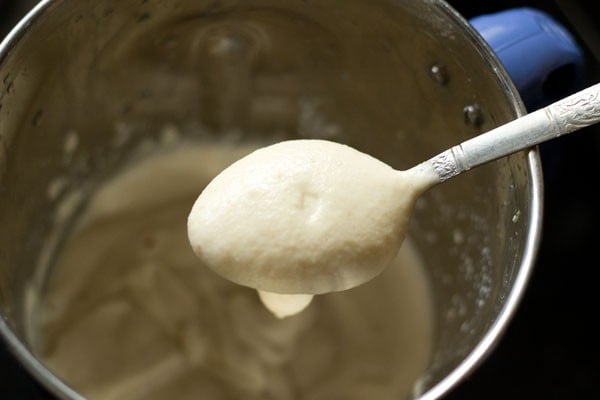

5. Take the batter in a bowl.
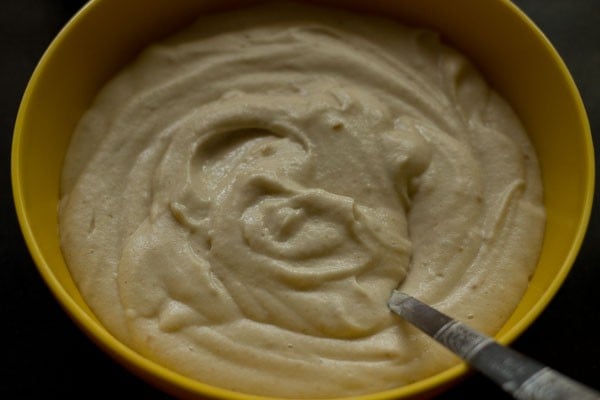

6. Add salt.
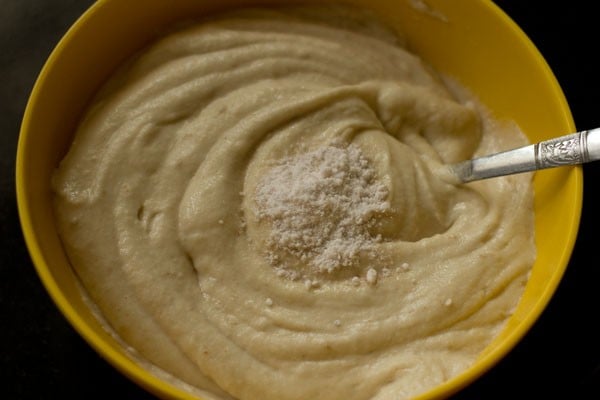

7. Stir the batter briskly for a couple of minutes. This brisk stirring makes the batter more light and fluffy.


8. The test to a correct consistency of this batter is the floating test. Take some water in a small bowl. Add 1 teaspoon batter in the water. The batter should float. If it does not float, the consistency is thin. Add some sooji or rice flour to the batter to thicken it.
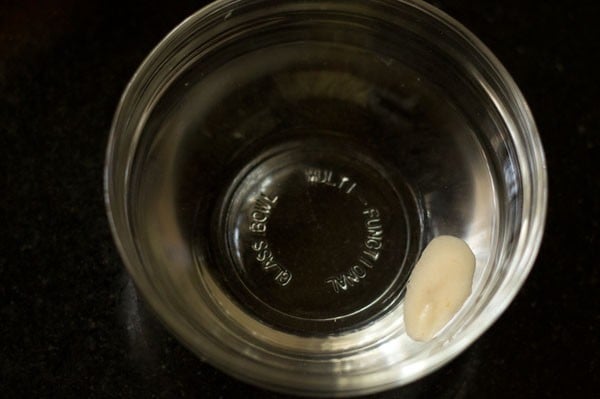

Frying bhalla
9. Heat a kadai or pan with oil for deep frying.
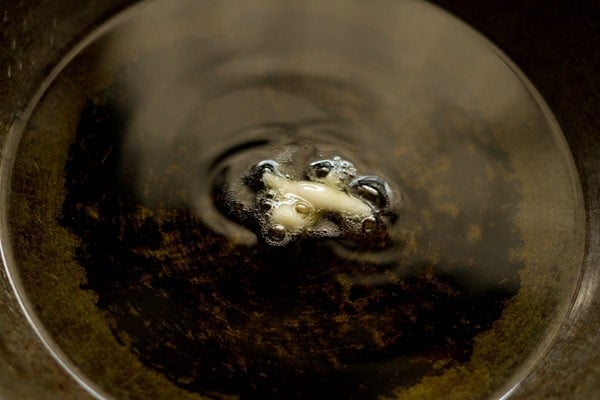

10. When the oil becomes medium hot, add a small amount of batter in the oil. It should come steadily and quickly on the surface. This means it is the right temperature to fry. Too cold oil will make the bhalla soggy and too high will brown them faster from outside, leaving the center uncooked.
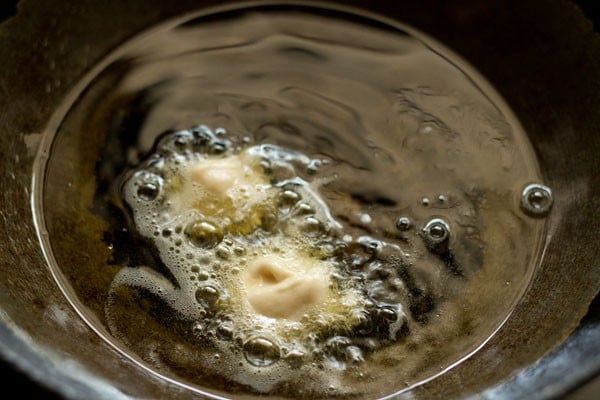

11. Add spoonfuls of the batter in the oil.


12. Add according to the capacity of the pan or kadai.
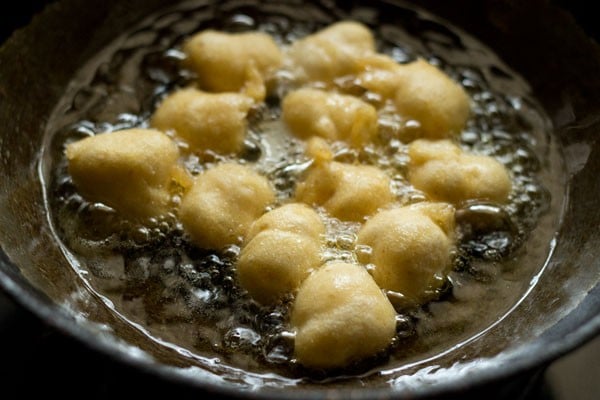

13. When bhallas are pale golden, turn them.
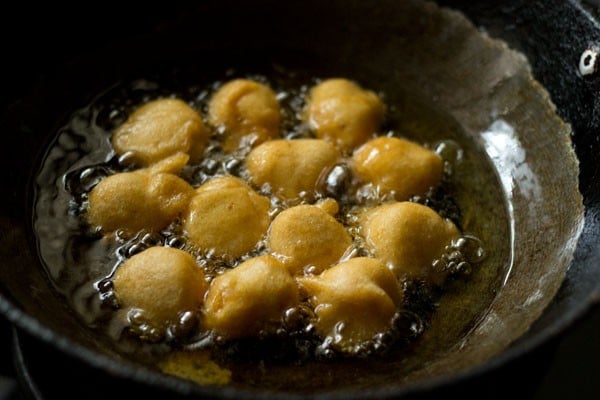

14. Fry the bhallas till golden and crisp. Turn a couple of times for even frying. Remove with a slotted spoon.
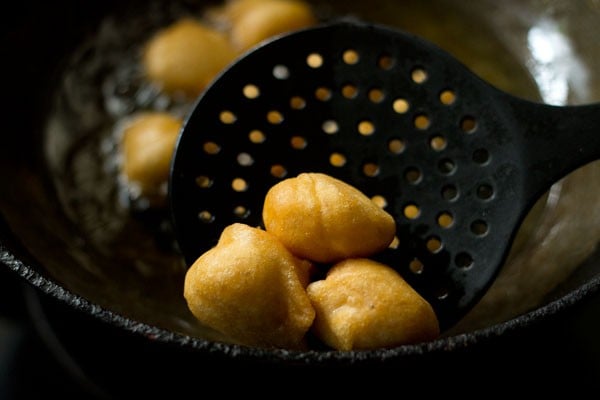

15. Drain on kitchen paper towels. Fry all the bhallas in the same way.
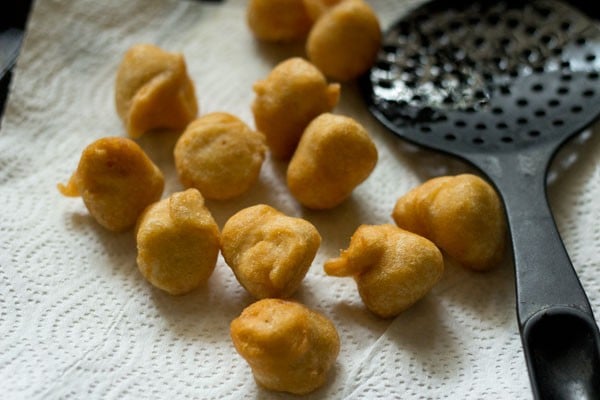

Soaking bhalla in water
16. Once all the bhallas are fried, take 2.5 cups water in a wide bowl or pan. Add the bhallas to the water.
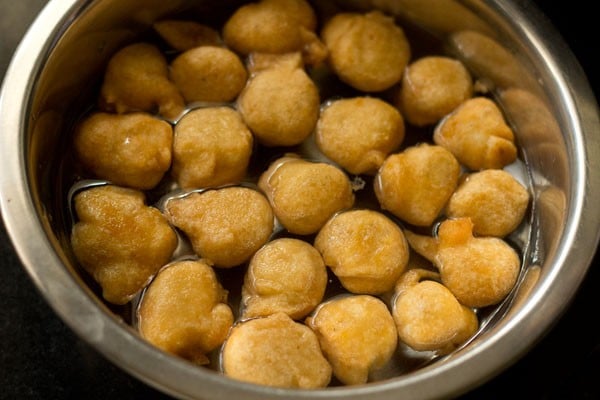

17. Soak them for 20 to 25 minutes.
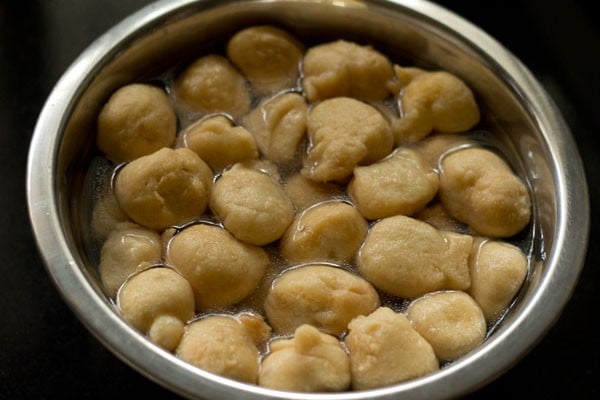

18. Take each bhalla, flatten and press between your palms to remove excess water.
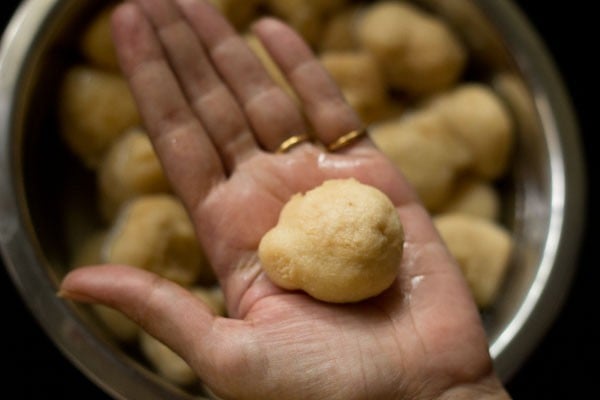

19. Do this with all the bhallas.


Making Dahi Bhalla
20. Take 2 cups fresh chilled curd in a bowl.
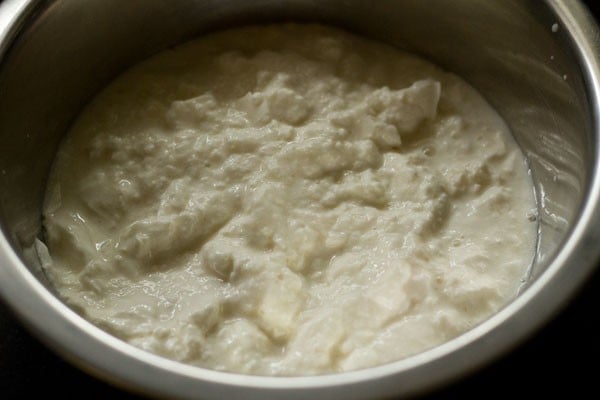

21. Beat the curd till smooth.
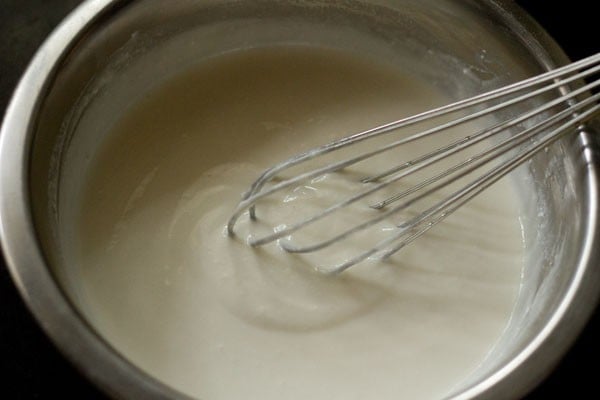

22. Now, gently place the bhallas in the curd.


23. Gently mix if you have used medium sized bowl, like how I have used. Now you can keep the bhallas with the curd in the refrigerator and assemble when you want to serve. Or use them right away as the curd is chilled.
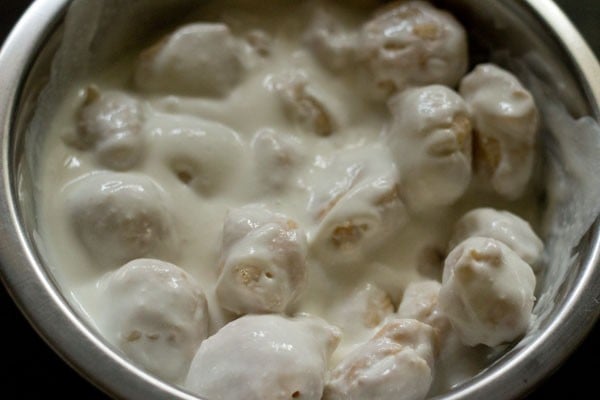

24. Gather all the other ingredients – boiled potato cubes, boiled white chickpeas, green chutney, tamarind chutney, fresh pomegranate arils and the spice powders.


Assembling Dahi Bhalla
25. To make individual portions of Dahi Bhalla, place 4 to 5 papdis on a plate.
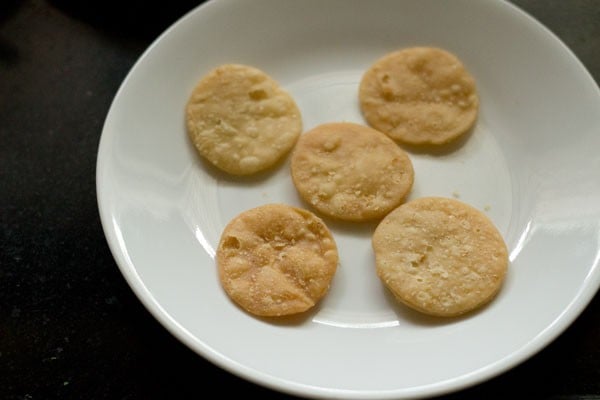

26. Place 2 to 3 Dahi Bhalla on the plate. Add more curd, if required.
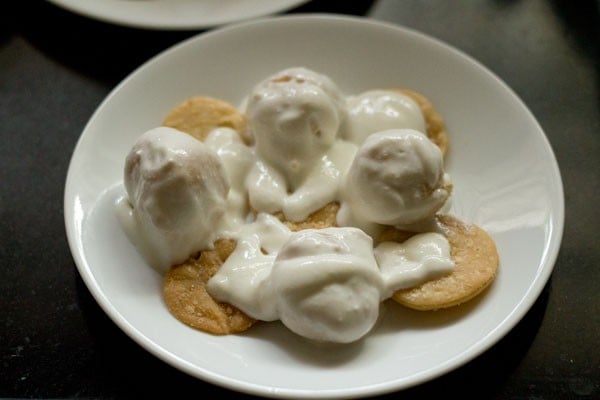

27. Top with some boiled potatoes and chickpeas.
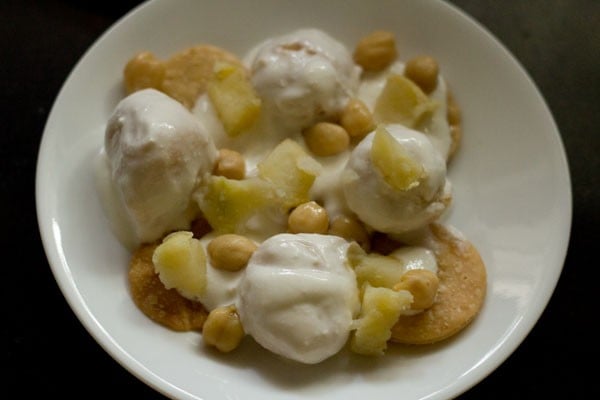

28. Now, add the green chutney and tamarind chutney.


29. Sprinkle red chili powder, roasted cumin powder, chaat masala powder, black salt as per taste and fresh pomegranate arils.


30. Serve Dahi Bhalla immediately. You can garnish it with some chopped coriander leaves or fine sev.


Expert Tips
- While making the batter for bhalle, you can also add 1 teaspoon roughly chopped ginger in it for an earthy taste.
- The quantity of water that needs to be added to grind the batter depends on the quality of lentils and the capacity or volume of the grinder. But make sure that you don’t add too much water as then the bhalle become too crispy and soak a lot of oil.
- Once the batter is ground, stir it briskly for some time as this will make the batter lighter and fluffier.
- Check the correct consistency of the batter with the floating test: add a teaspoon of batter in a small bowl of water. If it floats, it is perfect. It if doesn’t, it means the consistency is thin. To rectify this, add some sooji/rava or rice flour to the batter to thicken it.
- The oil for frying the bhalle should be at the right temperature. If it is too cold, bhalle will be soggy and if it is too hot, then the bhalle will brown faster from the outside and the center will be left uncooked.
- Use fresh curd for best results. To veganize this dish, use cashew curd. Also, keeping the bhalle dunked in curd for a longer time (atleast for 2 hours) makes the dish taste better.
- For toppings, you can use chopped coriander leaves, fine sev and finely chopped onions.
More Snacks Recipes To Try!
Street Food Recipes
North Indian Food
Street Food Recipes
Street Food Recipes
Please be sure to rate the recipe in the recipe card or leave a comment below if you have made it. For more vegetarian inspirations, Sign Up for my emails or follow me on Instagram, Youtube, Facebook, Pinterest or Twitter.


Dahi Bhalla | Dahi Bhalle Chaat
Popular and Tasty North Indian snack of dahi bhalla papdi chaat.
Prep Time 5 hours
Cook Time 30 minutes
Total Time 5 hours 30 minutes
other ingredients for dahi bhalla
for sweet tamarind chutney
Prevent your screen from going dark while making the recipe
making sweet chutney
Soak tamarind in water overnight or for 4-5 hours in a small bowl or pan.
With your hands, squeeze the pulp from the tamarind in the same bowl or pan.
Strain the pulp and keep aside.
Heat oil in a small pan. lower the flame & add cumin seeds and let them crackle.
Add ginger powder, red chili powder, asafoetida. Stir and add the strained tamarind pulp. cook for 2 to 3 minutes.
Add the jaggery and salt and cook for 4 to 5 minutes more. the mixture would thicken.
Let the saunth chutney mixture cool.
When cooled, store the saunth chutney in an air-tight dry jar or container.
making dahi bhalla batter
Rinse ½ cup urad dal and 4 tbsp moong dal in water a couple of times. Then soak both the lentils overnight or for at least 4 to 5 hours.
Drain them very well. Add the lentils to a grinder jar along with ½ tsp cumin seeds and a generous pinch of asafoetida. You can also add 1 tsp of roughly chopped ginger if you want.
Add water in parts and grind all the ingredients to a smooth fluffy batter. On touching the batter, it should not feel grainy. I added 6 to 7 tbsp water. Depending on the quality of lentils and the capacity-volume of grinder, you can add less or more water. Don’t add too much water as then the vadas become too crispy and soak a lot of oil.
Take the ground batter in a bowl and add salt.
Stir the batter briskly for a couple of minutes. This brisk stirring makes the batter more light and fluffy.
The test to a correct consistency of this batter is the floating test. Take some water in a small bowl. Add 1 tsp of a batter in the water. The batter should float. If it does not float, this means the consistency is thin. Add some sooji or rice flour to the batter to thicken it.
frying bhalla and soaking in water
Heat a kadai or pan with oil for deep frying.
When the oil becomes medium hot, add a small amount of batter in the oil. It should come steadily and quickly on the surface. This means it is the right temperature to fry. Too cold oil will make the vadas soggy with oil and too high will brown them faster from outside, leaving the center uncooked.
Add spoonfuls of the batter in the oil. Add according to the capacity of the pan or kadai.
When they become pale golden, then turn them.
Fry the vada till they become golden and crisp. Turn them a couple of times for even frying.
Fry till golden and crisp. Remove with a slotted spoon.
Drain on paper towels. Fry all the vadas in the same way.
Once all the vadas are done with frying, then take 2.5 cups water in a wide bowl or pan.
And add the vada to the water. Soak them for 20 to 25 minutes.
Take each vada and flatten and press between your palms to remove excess water. Do this with all the vadas.
making dahi bhalla
Take 2 cups fresh chilled curd in a bowl and beat it till smooth.
Now gently place these vadas in the curd.
Gently mix if you have used medium sized bowl, like how I have used. Now you can keep the vadas with the curd in the fridge and assemble when you want to serve. Or use them right away as the curd is chilled.
Gather and assemble all your other ingredients like – boiled potato cubes, boiled white chickpeas, green chutney, tamarind chutney, pomegranate arils and the spice powders.
To make individual portions of dahi bhalla, place 4 to 5 papdis in a plate.
Place 2 to 3 vada with the curd in a plate. Add more curd if required.
Top up with some boiled potatoes and chickpeas.
Now add the green chutney, sweet tamarind chutney as required
Sprinkle red chili powder, roasted cumin powder, chaat masala and black salt as per taste.
Serve dahi bhalla immediately garnished with some chopped coriander leaves. You can also garnish with fine sev.
- To veganize dahi bhalla, use cashew curd.
- The recipe can be halved.
- You can add finely chopped onions as a topping, if you want.
This Dahi Bhalla recipe from the archives was first published in March 2015. It has been updated and republished in April 2024.
[ad_2]


